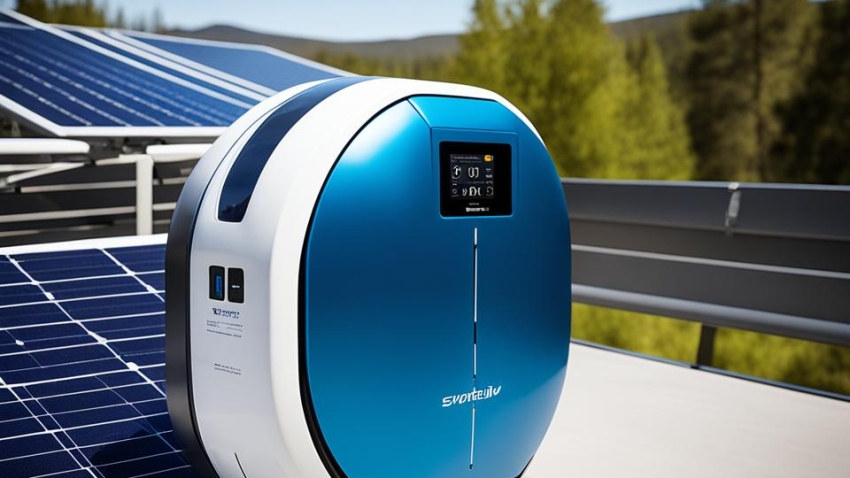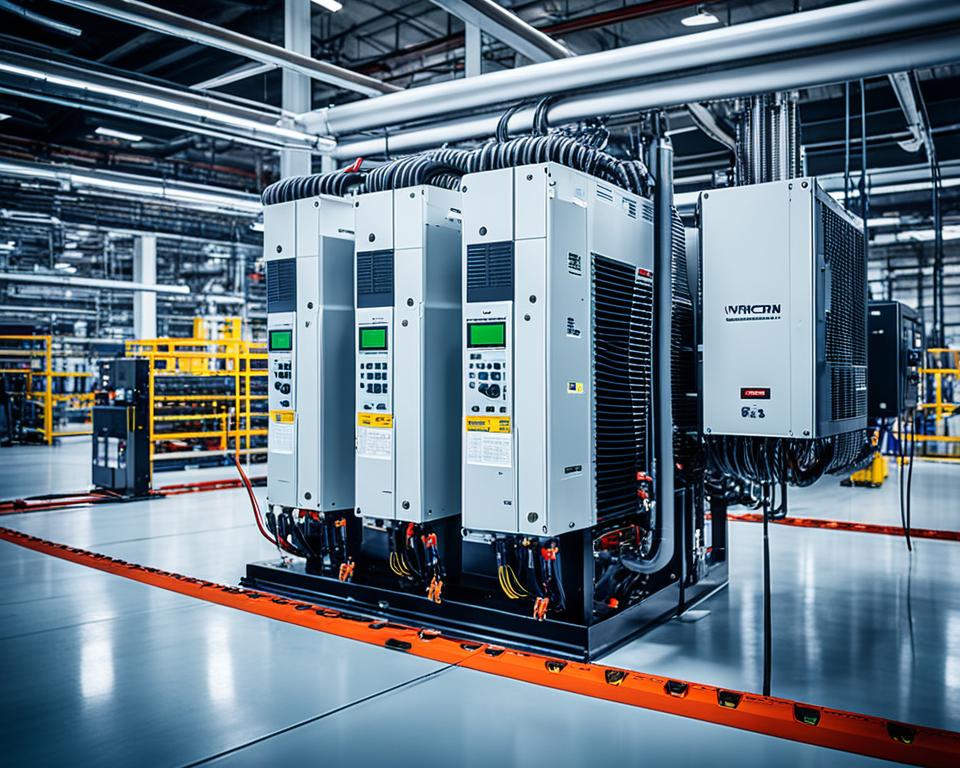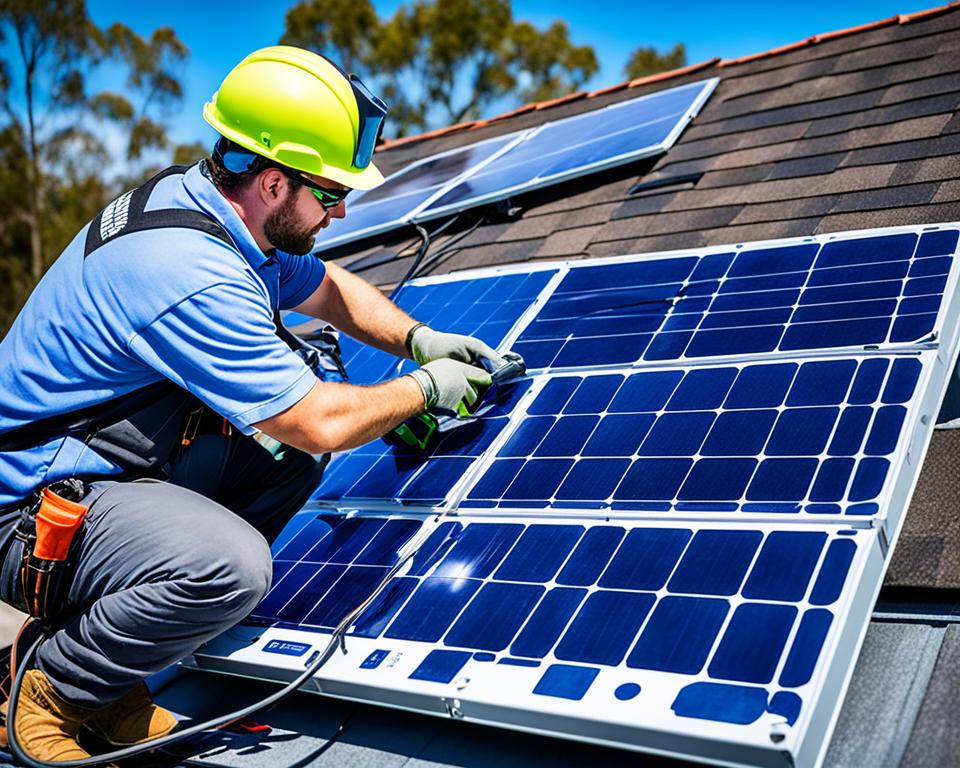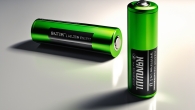
Hybrid Inverter: Efficient Power Management Solution
In today’s world, we all want to use energy wisely and protect the planet. That’s where the hybrid inverter comes in. It’s a new tech that combines solar power, battery storage, and regular electricity. This device is changing how we use renewable energy, making it flexible and efficient for our homes and businesses.
Read interesting things at : revolutionbookscamb
Key Takeaways
- Hybrid inverters combine solar energy, battery storage, and grid power for efficient energy management.
- They offer both grid-tie and off-grid capabilities, ensuring reliable backup power during grid outages.
- Hybrid inverters maximize the utilization of renewable energy sources, reducing reliance on fossil fuels.
- Smart features like energy monitoring and load management optimize energy consumption and cost savings.
- Hybrid inverters are versatile for residential, commercial, and industrial applications, bridging the gap between grid-dependent and off-grid power solutions.
What is a Hybrid Inverter?
A hybrid inverter is a cutting-edge technology that combines solar power, battery storage, and grid electricity. It’s a single system that helps homeowners and businesses use energy more efficiently. This device can do three things: work with the grid, stand alone, and charge batteries. It lets people use their energy better and be more independent.
Understanding Hybrid Inverter Technology
Hybrid inverters use advanced tech to manage energy from different sources. They can switch between using the grid and working on their own, keeping power on during outages. This is thanks to smart power electronics and algorithms that make sure solar energy, battery storage, and grid electricity work together well.
Benefits of Hybrid Inverter Systems
- Enhanced energy independence: Hybrid inverters let users make, store, and use their own clean energy. This cuts down on grid use and lowers bills.
- Improved power reliability: They can switch between using the grid and being off-grid. So, there’s always power when the grid goes down.
- Increased energy efficiency: Hybrid inverters use solar energy, battery storage, and grid power smartly. This means less energy is wasted.
- Flexible system integration: Hybrid inverters fit into new or old solar PV setups. They’re great for homes and businesses alike.
- Reduced carbon footprint: Using renewable energy with hybrid inverters helps make the planet greener. It also lowers the harm done by energy use.
As we move forward with renewable energy, hybrid inverters are changing the game. They give people and businesses the power to manage their energy needs. They support the use of hybrid inverter technology, solar hybrid inverters, and PV hybrid inverters.
Components of a Hybrid Inverter System
A hybrid inverter system has a key part called the inverter. It turns solar energy from panels into AC power we can use. It also takes care of charging and using the battery bank efficiently. Around this inverter, there are other important parts that work together to make a full hybrid power solution.
Solar panels catch the sun’s energy and turn it into electrical current. The battery bank, made of lithium-ion or lead-acid batteries, saves extra energy for when we need it most or when the grid goes down.
- Hybrid inverter: The central component that converts solar energy into AC power, manages battery charging and discharging, and facilitates grid integration or off-grid operation.
- Solar panels: The renewable energy source that generates electrical current from sunlight.
- Battery bank: The energy storage system that stores excess solar power for later use.
Hybrid inverter systems also have control and monitoring parts. These include charge controllers to manage electricity to and from the battery bank. And energy management systems to make the system work better and more efficiently.
| Component | Function |
|---|---|
| Hybrid Inverter | Converts solar energy into AC power, manages battery charging and discharging, and facilitates grid integration or off-grid operation. |
| Solar Panels | Generates renewable energy by converting sunlight into electrical current. |
| Battery Bank | Stores excess solar power for later use during periods of high demand or grid outages. |
| Charge Controller | Regulates the flow of electricity to and from the battery bank, ensuring optimal charging and discharging. |
| Energy Management System | Optimizes the performance and efficiency of the hybrid inverter system. |
Knowing about the main parts of a hybrid inverter system helps people make smart choices. They can pick a sustainable energy solution that fits their power needs and uses solar energy well.
Hybrid Inverter: Bridging the Gap
Hybrid inverters are great because they connect grid-tied and off-grid power systems smoothly. They work in both modes, letting people use renewable energy well. This keeps the power on, even when the grid goes down.
Grid-Tie and Off-Grid Capabilities
In grid-tied mode, a grid-tie hybrid inverter sends extra solar energy to the grid. This lowers energy bills and helps the local power grid. On the other hand, in off-grid mode, the off-grid hybrid inverter uses the battery bank for backup power. This keeps important devices running during power cuts or grid failures.
This flexibility is a big deal for those wanting to use renewable energy reliably. The hybrid inverter grid-tie and off-grid features let users switch between modes easily. This way, they can use the best of both worlds as their energy needs change.
“Hybrid inverters are the future of energy management, empowering homeowners and businesses to take control of their power supply while embracing the benefits of renewable energy.”
Hybrid inverters combine grid-tied and off-grid features for a full solution. They fill the gap between old power systems and the need for sustainable energy.
Hybrid inverters change how we manage energy. They let people send extra solar energy to the grid or use it for backup during outages. With these features, users can switch between grid-tied and off-grid modes easily. This meets their changing energy needs.
Energy Management with Hybrid Inverters
Hybrid inverters are changing how we handle energy, especially with solar power. They are great at using renewable energy well. They link solar panels, battery storage, and grid power for a full energy management system.
Maximizing Solar Energy Utilization
Hybrid inverters are great at using solar energy fully. They watch how much energy we use and use solar power first. This means we use less grid electricity, pay lower bills, and produce less pollution.
They also manage the battery’s charging and discharging well. They charge the battery with solar energy when it can. If we need grid power, they use the battery instead, making the most of hybrid inverter solar energy utilization.
This smart energy management with hybrid inverters lets people and businesses control their energy better. It helps them use their solar power well and use less traditional electricity.
“Hybrid inverters are the future of smart energy management, enabling us to maximize the utilization of renewable resources and reduce our environmental impact.”
Hybrid Inverter for Residential Applications
Hybrid inverters are changing the game in home power management. They combine solar panels, battery storage, and grid connection. This lets homeowners control their energy use and cut down on utility bills.
With a hybrid inverter for homes, homeowners can use more renewable energy. Solar panels make clean electricity, lowering carbon emissions and energy costs. The inverter stores extra energy in batteries for use during outages, ensuring a steady power supply.
The residential hybrid inverter helps the environment and homeowners. It promotes solar energy and smart energy use. This is key to a greener, more independent energy future.
The solar hybrid inverter for homes gives homeowners more control over their energy. They can track and manage their energy use. This helps them use their renewable energy wisely, making their system more efficient and cost-effective.
| Feature | Benefit |
|---|---|
| Solar Energy Integration | Generates clean, renewable electricity for the home |
| Battery Storage | Stores excess energy for use during grid outages or peak demand |
| Grid Connectivity | Enables homeowners to sell excess energy back to the grid or draw from it when needed |
| Energy Management | Allows homeowners to monitor and optimize their energy usage |
Hybrid inverters offer a full energy management solution for homeowners. They empower homeowners to manage their energy, reduce their environmental impact, and save money over time.
“Hybrid inverters are revolutionizing the way homeowners approach their energy needs, offering a sustainable and cost-effective solution that puts them in the driver’s seat of their power consumption.”
Commercial and Industrial Use of Hybrid Inverters
Hybrid inverters are not just for homes; they’re great for businesses too. They help use solar energy better, manage battery storage, and work with the grid. This cuts down on energy costs and carbon emissions, and keeps power flowing during outages.
Hybrid Inverters for Commercial Use
Places like offices, stores, and warehouses can really benefit from commercial hybrid inverters. These systems make it easier to use solar energy, cutting down on grid reliance and energy bills. They also keep the power on during outages by storing energy in batteries.
Hybrid Inverters for Industrial Applications
In industries, industrial hybrid inverters are key for saving energy. Factories and other big energy users can use these systems to tap into solar power and have a steady backup power supply. This makes energy use more efficient and cheaper.
| Feature | Commercial Hybrid Inverters | Industrial Hybrid Inverters |
|---|---|---|
| Energy Optimization | Enables businesses to harness solar energy more effectively, reducing reliance on the grid and lowering electricity expenses. | Allows industrial operations to leverage renewable energy sources, such as solar, while maintaining a reliable backup power supply through battery storage. |
| Backup Power | Integrates battery storage to ensure a continuous power supply, safeguarding operations during unexpected outages. | Provides a reliable backup power supply, ensuring uninterrupted operations even during grid disruptions. |
| Sustainability | Enables businesses to reduce their carbon footprint and adopt a more environmentally-friendly approach to energy management. | Promotes a more sustainable and cost-effective approach to energy management for industrial facilities. |
Using hybrid inverters for commercial use and hybrid inverters for industrial use helps businesses use energy better. It makes operations more efficient and supports a greener future.

Smart Features of Hybrid Inverters
Modern hybrid inverters now come with smart features that make them more useful and efficient. These smart features help users manage their power better and get the most out of their renewable energy setups.
One big feature is their ability to monitor and control energy use in real-time. They give users detailed info on how much energy they’re making, using, and storing. This lets people or businesses make smart choices about their energy use. Many hybrid inverters work with apps or websites, so users can check on their energy use from anywhere.
They also work well with smart home or building systems. This hybrid inverter smart technology helps manage energy use across different systems like heating, lights, and appliances. This makes using energy more efficient and can save money.
The intelligent hybrid inverter tech also uses smart algorithms to predict energy needs and make decisions automatically. It can adjust how it stores and sends energy to meet these needs. This makes the whole renewable energy system work better.
Overall, the smart features of hybrid inverters are a big leap in managing and optimizing power. They offer advanced monitoring, control, and integration. This helps people, businesses, and communities use energy more independently and sustainably.
“Hybrid inverters are transforming the way we manage and optimize energy consumption, making renewable energy solutions more accessible and practical than ever before.”
- Real-time energy monitoring and data analysis
- Remote access and control through mobile apps and web portals
- Integration with smart home and building management systems
- Predictive analysis and automated decision-making capabilities
- Enhanced energy efficiency and cost savings
Selecting the Right Hybrid Inverter
Choosing the right hybrid inverter for your home or business is important. You need to think about your solar array size, energy use, and battery storage. Also, consider your grid or off-grid setup, inverter efficiency, power rating, and compatibility with your system parts. This ensures a smooth and effective hybrid inverter setup.
Factors to Consider
Let’s look at the main things to think about when picking a hybrid inverter:
- Solar Array Size: Know how big and powerful your solar panel system is. This helps pick the right hybrid inverter for your needs.
- Energy Consumption Patterns: Check how much energy your home or business uses. This helps pick the right hybrid inverter size and features.
- Battery Storage Capacity: Think about how much battery storage you have. This affects the hybrid inverter you choose and its energy storage abilities.
- Grid or Off-Grid Requirements: Decide if you need a hybrid inverter for the grid or off-grid use. This decides what features and capabilities you need.
- Inverter Efficiency: Choose a hybrid inverter with high efficiency to make the most of solar energy. This reduces energy waste.
- Power Rating: Make sure the hybrid inverter has the right power for your energy needs. It should not overload the system.
- Compatibility: Check that the hybrid inverter works well with your solar panels, batteries, and other energy devices.
By thinking about these factors, you can pick the best hybrid inverter for your energy needs. This will help you manage energy better, use solar energy well, and keep your power reliable for your place or business.
“Choosing the right hybrid inverter is crucial for maximizing the efficiency and performance of your energy system.”
Installation and Maintenance of Hybrid Inverter Systems
Installing and keeping up with a hybrid inverter system is key for its good performance and reliability. The setup needs careful sizing, right wiring and grounding, and fitting well with solar panels, battery banks, and the electrical grid or off-grid power sources.
For a smooth setup, it’s smart to hire experts who know your energy needs well. They can make a hybrid inverter system just for you. They’ll help you pick the right gear and make sure everything is connected safely and correctly.
Key Steps for Hybrid Inverter System Installation
- Figure out your energy needs and pick the best hybrid inverter model
- Size and set up the solar panels, battery bank, and other parts right
- Make sure wiring and grounding are done right to follow local electrical rules and keep things safe
- Link the hybrid inverter to the grid or off-grid power source
- Test the system well to check it works as it should
Maintaining Your Hybrid Inverter System
Keeping your hybrid inverter system in top shape is important. This means:
- Watching how the system does and fix any problems fast
- Regularly checking electrical connections and tighten them if needed
- Updating firmware to keep your system current
- Cleaning solar panels to remove any dirt
- Looking over battery banks and replacing them when it’s time
By doing the right things for installation and maintenance, you can make the most of your hybrid inverter. This means better performance, reliability, and a longer life for your investment. It also means you’ll have a green and efficient way to manage your power.
| Key Considerations for Hybrid Inverter Installation | Importance |
|---|---|
| Proper Sizing | Ensures the inverter can handle your energy needs without over or under-performing |
| Electrical Wiring and Grounding | Keeps things safe and follows local rules |
| Integration with Solar, Batteries, and Grid/Off-Grid | Helps manage power well and optimize energy use |
| Thorough Testing | Checks the system works right and fixes any problems early |

“Proper installation and maintenance of a hybrid inverter system are critical to its long-term performance and reliability.”
Hybrid Inverter: A Sustainable Solution
Hybrid inverters are key to a greener energy future. They blend solar power with storage and connect to the grid. This helps homes and businesses use less fossil fuel and cut down on carbon emissions. They’re vital for making renewable energy more common and supporting a greener, stronger power system.
The fight against climate change makes sustainable energy crucial. Hybrid inverter tech leads this effort. It offers a full solution by combining renewable energy, storage, and grid connection.
Hybrid inverters make the most of renewable energy. They manage energy flow between the grid, solar panels, and storage. This way, they use as much clean, sustainable energy as possible, reducing fossil fuel use.
These inverters also boost power system resilience. In outages, they switch to off-grid mode, keeping energy flowing. This is especially useful in areas hit by disasters or grid problems, helping build a stronger, greener energy network.
The push for renewable energy means hybrid inverter tech is more important than ever. It lets people and communities control their clean energy. This is changing the energy landscape to be more sustainable and self-sufficient.
“Hybrid inverters are the key to unlocking the full potential of renewable energy, enabling a future where clean, reliable power is accessible to all.”
Cost-Effectiveness of Hybrid Inverters
The need for renewable energy is growing fast. Hybrid inverters are becoming more popular because they save money and are a smart investment. These devices change energy efficiently and help save money over time for homes and businesses.
Long-Term Savings and Return on Investment
A cost-effective hybrid inverter cuts energy costs over time. It combines solar power with grid electricity to reduce the need for expensive grid power. This leads to big savings for homeowners and businesses.
Hybrid inverters with energy storage save even more money. They store extra solar power for use during high demand or when grid prices are high. This way, users save even more on energy costs.
| Comparison | Traditional Inverter | Hybrid Inverter |
|---|---|---|
| Energy Savings | Relies solely on grid electricity, subject to utility rate fluctuations | Integrates renewable energy sources, reducing grid electricity dependence |
| Return on Investment | Typically lower due to ongoing energy costs | Improved ROI through long-term energy savings and potential incentives |
| Environmental Impact | Continues to rely on grid electricity, which may include fossil fuel-based sources | Promotes sustainability by increasing renewable energy utilization |
Installing a cost-effective hybrid inverter might get you incentives and tax credits. These programs help people use renewable energy more. They offer extra money savings.
“The integration of renewable energy and energy storage in hybrid inverters can significantly improve the long-term cost savings and ROI for users, making them a highly attractive option for sustainable power management.”
Hybrid inverters balance grid and off-grid power. They are a smart choice for managing power. They save money over time and offer a good return on investment for those who use them.
Future Trends in Hybrid Inverter Technology
The demand for renewable energy and energy storage is growing fast. This means big changes are coming for hybrid inverter technology. We’ll see more efficient and smaller inverters, better control algorithms, and new battery technologies.
These changes will make hybrid inverters work better, be more versatile, and cheaper. They will be key in moving to a sustainable energy future. Hybrid inverter tech will help make renewable energy more common, work well with the grid, and provide reliable backup power for homes and businesses.
One big trend is making inverters more efficient and smaller. Companies are working to make them lighter and more efficient. This means they can be used in more places and are easier to install. These changes will make systems work better together, cost less to install, and perform better overall.
Another trend is using smart technology in hybrid inverters. These smart systems can manage energy flow better, using more renewable sources and storing energy well. This lets people control their energy use better, making hybrid inverters more appealing.
Also, new battery technologies will be key in hybrid inverter tech. Better batteries mean more backup power and better energy management. This makes hybrid inverters a top choice for those wanting sustainable energy solutions.
The future of hybrid inverter tech is full of promise. These changes will make hybrid inverters work better and help us move to a sustainable energy future. As these trends grow, hybrid inverters will play a big role in powering our daily lives.
| Emerging Trends | Impact |
|---|---|
| Efficient and Compact Inverter Designs | Improved system integration, reduced installation costs, and enhanced overall system performance |
| Advanced Control Algorithms and Machine Learning | Optimized energy management, enhanced monitoring and control capabilities for homeowners and businesses |
| Cutting-Edge Battery Technologies | Extended backup power and greater flexibility in energy management, supporting the transition to sustainable energy solutions |
“The future of hybrid inverter technology is brimming with possibilities, promising advancements that will revolutionize the way we harness and manage renewable energy.”
Conclusion
Hybrid inverters have changed how we handle power, combining renewable energy, battery storage, and grid connections. They give homeowners and businesses a full solution for managing power well. This includes using solar energy fully and having backup power during outages.
These inverters are becoming key for those wanting to use less energy and cut down on carbon emissions. They offer smart energy management and remote monitoring. This makes them easy to use and connect with other power systems.
The future of hybrid inverters looks bright as they keep getting better. They’re getting more efficient, storing more energy, and easier to use. These devices will help us move towards a sustainable and strong energy future. By using hybrid inverters, we’re making a cleaner, reliable, and cheaper energy system closer to reality.









Leave a Reply